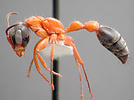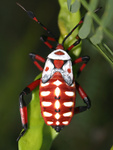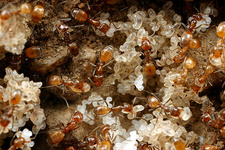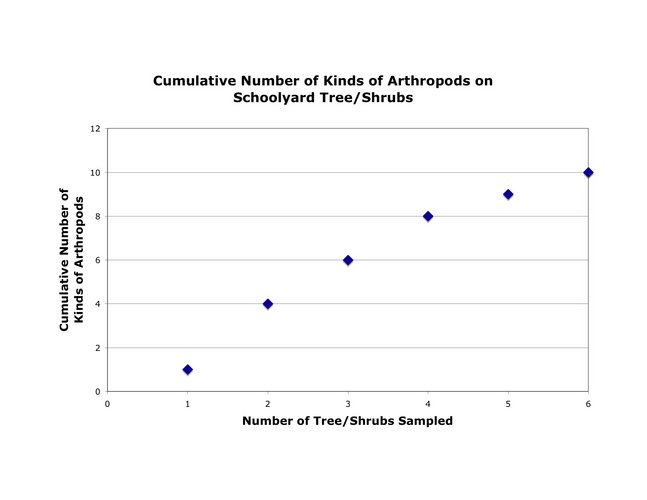Activities
- Sampling arboreal arthropods
- Identification of common local bird species
- Testing the biodiversity sampling effect with real data
- Recording and graphing data
- Analyzing diversity data from the Tucson Bird Count
Overview and Opportunities
- Learn about the relationship between habitats and biodiversity
- Identify common local birds
- Understand the problems with measuring diversity
- Meet renowned professor of biodiversity from University of AZ
Biodiversity Information
Scientists have described over one million species that live here on Earth, and they estimate that many millions more await discovery. How has our planet come to hold such a tremendous diversity of life? One explanation for this diversity lies in the diversity of habitats found on Earth. No one species has the ability to live everywhere on our planet. Certain species are found only in the arctic tundra and others only in the tropical rainforest. Why doesn’t one species simply evolve the ability to live in all the different environments on the planet? Because species exhibit tradeoffs in their abilities to deal with different environmental conditions. These tradeoffs in combination with an enormous variety of habitats are what have led to the extraordinary biodiversity of our planet.
What is a habitat? A niche?
Habitat
A habitat is the place in which an organism lives. Let’s consider some species found in the Sonoran Desert. The Gila woodpecker is a species of bird found throughout the Sonoran Desert in low elevation desert scrub environments. Thus the habitat of the Gila woodpecker consists of the low desert scrub environments of the Sonoran Desert. Although the low desert scrub environment is a habitat in its own right, there are many other smaller habitats contained within this single larger habitat. Smaller habitats contained with larger habitats are called microhabitats. For example, cactus rots are important microhabitats within the low desert scrub environment. A cactus rot is created when a cactus dies or is damaged and begins to decompose. Many species of bacteria, yeasts, and arthropods make their home in cactus rots.
Climate& Biomes
Climate is an important physical feature of all habitats. Climate is defined as the average long-term weather patterns of a geographical area. Two of the most important components of climate are temperature and rainfall. The different climates across the planet help to create the earth’s different biomes. For example, arid climates, defined as areas with low annual rainfall, usually result in desert biomes. Can you list the other biomes that exist on our planet?
The following link will take you to the Fundamentals of Physical Geography Online Textbook, which provides a description of Earth’s eight major terrestrial biomes.
http://www.physicalgeography.net/fundamentals/9k.html
Niche
Now that we know how to define an organism’s habitat, how do we define an organism’s niche? A habitat is the place in which an organism lives, whereas a niche is the role an organism plays in its environment. The niche of each species differs in some way from the niches of all other species. An important part of every species' niche is its diet. For example, suppose there are two fly species that make their home in the same type of cactus rot but feed on different foods found in the rot. Flies of the first species feed on yeasts, whereas flies of the second species feed on other insects. Although these two species share the same habitat, diet differentiates their niches. There may be other differences in their niches as well. Perhaps these species uses the cactus rot at different times. In this case, time and diet would both help differentiate the niches of these two species.
Activity: What do you know about habitats?
Think about the different habitats that you can find in southern Arizona.
- On your own or with friends, make a list of five different habitats in southern Arizona.
- Now pick one of those five habitats from your list and describe five more habitats contained within that single habitat. (Hint: Think about the habitats of small organisms like reptiles and insects.)
Arthropods and Plants
Many arthropods have intimate relationships with plants. This is especially true for insects, which are one of the main groups within the Phylum Arthropoda. Herbivorous insects depend on plants for food. In order to minimize the damage done by hungry insects, plants are constantly evolving new defenses to protect themselves from herbivory. Insects, in turn, are constantly evolving ways to overcome new plant defenses. Besides serving as food, plants also serve as shelter and as places for insects to mate and reproduce. Insects make their homes in just about every plant part imaginable. Some insects live entirely within the leaves of plants, others nest in stems or branches, and other under bark or in the trunk itself. It is doubtful that there is any plant out there that is not used in some fashion by some insect or other arthropod. Later in this module you will learn one method for studying the variety arthropods that live on trees and shrubs in the Sonoran Desert.
What exactly is an arthropod? Arthropoda is one of many phyla (singular: phylum) in the kingdom Animalia. The principal characteristics of an arthropod are:
- A segmented body
- Bilateral symmetry
- Hard exoskeleton
- Paired segmented appendages (jointed legs)
Within the phylum Arthropoda are many different classes of arthropods. For example, spiders, scorpions, and ticks are in the class Arachnida, and horseshoe crabs are in the class Merostomata. Insects are classified as Hexapoda. The Hexapoda all share the following characteristics:
- Three segmented body (Head + Thorax + Abdomen)
- Six legs arising from the thorax
- One pair of antennae
- One pair of mandibles
More information on arthropods:
The Arthropod Story (http://tolweb.org/treehouses/?treehouse_id=3923)
Introduction to the Arthropods (www.ucmp.berkeley.edu/arthropoda/arthropoda.html)
Sampling Arthropods with the Beat Sheet Method
Materials Needed
• field journal and pencil
• sturdy wooden stick
• white cloth or sheet
• paintbrush
• forceps
• three or four clear glass jars with lids
Look for an area in your schoolyard that has some trees and/or shrubs. Hopefully you can find an area that has a variety of trees and shrubs. Native species such as mesquite and palo verde would make good choices for this experiment. You will use the beat sheet method to sample the arthropods from three trees/shrubs of the same species and from three trees/shrubs of different species. To do this you should work in groups of four. One person will beat one branch of the selected tree/shrub quickly two times in a row. The amount of force you will need depends on the sturdiness of the tree/shrub. Do not damage the tree/shrub! Two people will hold a white cloth of about 1 square meter in size, below the branch to catch the arthropods that fall from the tree/shrub. After the arthropods have fallen onto your sheet, you can place the sheet on the ground and record the numbers and types of arthropods on the sheet. Some of the arthropods will attempt to run, jump, or fly away from the sheet. Collect these individuals in your clear glass jars. Delicate arthropods can be collected with the paintbrush, sturdier arthropods with the forceps.
Don't be afraid of insects! You probably will not collect any stinging insects, most will probably be beetles, bugs, ants and spiders. There is one type of ant in southern Arizona that lives on trees and has a powerful sting, but it moves so fast we doubt you will be able to catch it. Likewise, most bees and wasps wil fly away before you are able to catch them.
Check out some pictures below of insects you may find on your beat sheet if you collect on a mesquite tree.


Be careful of this ant that lives on Mesquite trees, as it has a powerful sting. Pseudomyrmex sp.. © 2004 Chris A. Schmidt


Giant Mesquite Bug, Thasus sp.. © 2005 Chris A. Schmidt
After you observe these individuals you can release them back onto the tree/shrub from which they came. Repeat this method six times with three different individuals of the same tree/shrub species and different tree/shrub species.
Field Journal Tips
Before you begin sampling, each group member should write down this basic information in their field journal.• site name/location
• names of the people in your group
• date and time of day
• weather conditions: for example, is it hot, cool, windy, sunny?
Then after this information has been recorded, write down the name of the first tree/shrub that will be sampled. Underneath you will record information about the arthropods from this tree/shrub. Below are some features of the arthropods you might want to record.
• number of legs (8 legs = arachnid; 6 legs = insect)
• other appendages (Does this organism have wings, antennae, a stinger, etc.?)
• mouthparts (How might this organism feed?)
• eyes (How many eyes does the organism have? Are they big/small?)
• color (Is the organism brightly colored?)
When you sample the second tree/shrub, you might find the same kind of arthropod that you found on the first tree/shrub. If you assign simple names to your arthropods (eg. beetle 1), you can avoid the need to rewrite a description. Also be sure to record the number of each type of arthropod that fell onto the sheet. When you return to the classroom, you can tally the number of different kinds of arthropods from the different trees/shrubs. Your data sheet might look something like this:
| Beetle 1 | Beetle 2 | Beetle 3 | Beetle 4 | Spider 1 | Spider 2 | Ant 1 | Ant 2 | Bug 1 | Bug 2 | Bug 3 | |
| Mesquite-1 | |||||||||||
| Mesquite-2 | |||||||||||
| Mesquite-3 | |||||||||||
| Pine-1 | |||||||||||
| Olive-1 | |||||||||||
| Acacia-1 |
- Did you find the same kind of arthropods on all of the different trees/shrubs that you sampled?
- Which type of tree/shrub produced the largest number of arthropods? Which type of tree produced the most kinds of arthropods?
- If you know which trees/shrubs are native and non-native to the Sonoran Desert, compare the number and diversity of arthropods found on the native species to that on the non-native species.
- Descriptive statistics are one of the simplest methods of summarizing your data. Using your data sheet calculate the mean, frequency, and range for the number of athropods per tree/shrub.
Graph It!
Although you only made a small number of observations, you may have found that different kinds of arthropods are found on different tree/shrub species. Many arthropods, and insects in particular, have strong relationships with particular plant species. Since many insect species are dependent on certain plant species for food and shelter, the more plant species you sampled the more insect species you likely encountered. Visualizing your data with a graph can often help to identify patterns in the data. Make a scatterplot of your data to check for this relationship. The x-axis should be the number of trees and the y-axis should be the number of different kinds of arthropods. We will discuss this relationship more below.
Developing Questions, Hypotheses and Testing Your Hypotheses
What is a hypothesis? A hypothesis is a tentative explanation for observations of the natural world. You made a number of observations of the arthropods living on the trees and shrubs in your schoolyard. Did you see any patterns in the data you collected? Perhaps you found a large number of insects only on one particular type of tree in your schoolyard? This observation might lead to a question. For example, why is the abundance of insects much higher on tree A than on trees B and C? A hypothesis could be developed to provide a tentative answer to this question. A hypothesis must be tested to verify if it is true or false. Suppose that tree A was flowering, and the other trees were not. In this case, one hypothesis might go as follows - A higher abundance of insects was found on tree A than on trees B and C because tree A was providing food in the form of leaves and pollen and nectar (from flowers), whereas the trees B and C were only providing food in the form of leaves. This is just one possible explanation among many. The next step is to design a test for this hypothesis.
Think about the observations that you made and come up with a question (or more than one) that relates to one of the patterns that you found in your observations of the arthropods living on trees and shrubs in your schoolyard. Develop three hypotheses to answer this question or questions, and then think of ways that you might be able to test these hypotheses.
Develop a Plan to Test Your Hypotheses
After you have some ideas about how you might test one or more of your hypotheses, develop a plan to actually carry out your test. You will need to think carefully about the resources available to you. Actually, all scientists, even those at the most prestigous intitutions, are limited by the available resources. Conducting experiments can be difficult and may require expensive equipment. You might have a great idea for testing your hypothesis, but if you do not have the resources to properly conduct this test, try to think of other ways to test the hypothesis. In the end you might not have to test one of your other hypotheses for the patterns you observed and that's okay. Even if you think that one hypothesis provides a more likely explanation than the others, you will learn a lot by testing any of your three hypotheses.
Once you have a plan, and have had your plan approved by your teacher, begin your experiment. Expect that things will not go exactly as you planned, and don't be discouraged. You will learn a lot by the problems that pop up. The natural world, even a small, seemingly simple school yard, can be quite complicated. You will be amazed by how much you can learn through observation and experimentation.
Communicating Your Results
An important part of any type of science is communicating the results of your work. In this stage you take all the work that you did forming your questions and hypotheses, observing, following the steps of the experiment, creating graphs and analyzing your data and write it up to share in text, graphic and spoken form with others. Usually scientists write a paper, then create a power point or other type of presentation in order to share their research at a conference or meeting as an oral presentation.
Here are the components that should be in your report:
- Introduction
- Background Information
- Questions, Hypotheses
- Materials
- Procedure
- Analysis
- Figures (graphs)
- Findings/Discussion
- Conclusion
- Future Research
The Species-Area Relationship
One of the most documented patterns in nature is called the species-area relationship. In fact, the species-area relationship is one of the few laws of ecology. The species-area relationship simply stated says that as larger and larger areas are sampled, more and more species will be discovered.
Let’s consider an example. Suppose you decide to sample the insects of a grassland habitat with a sweep net. A sweep net is simply a net attached to the end of a pole that you swing in an arc in front of you as you walk through the grassland vegetation. If you sweep your net over an area of 10 square meters you will likely catch more insect species than if you sweep your net over an area of 5 square meters.
There are two reasons that larger areas contain more species. The first is simply that in the larger area we will most likely catch more individual insects than in the smaller circle, and larger samples produce larger numbers of species. This is called the sampling effect.
The second reason has more to do with the biology of the insects living on the vegetation. As you increase the area that you sample, you increase the number of different habitats you sample. Since animals have specific habitat requirements, the more habitats you sample the more different species you will find.
Collaborate/Talk about it:
• Blog to share some of your observations. Your class can make a blog by using wordpress, blogger, or a host of other blogging platforms (we like wordpress).
• Use a class wiki - your class can use pbwiki.com, or wikispaces.com to create a class wiki.
Natural History Observation (Birds)
Background
The Sonoran Desert is an extraordinary place for birds. Approximately half of the total number of bird species in the U.S. spend at least part of their lives in the Sonoran Desert. Familiarize yourself with the most common birds in the Tucson area:
- Backyard Birds of Tucson, AZ
- Tucson Bird Count, www.tucsonbirds.org.
We will be using data from Tucson Bird Count later to visualize the species-area relationship
Science Notebook
Now that you have learned about Tucson’s bird diversity, select one species for detailed observation and study. You should select a bird that you will be able to observe frequently either at home, at school, or at a nearby park. Observations of your species can be made any time. The more observations you make, the better your natural history description will be. If possible, make observations during different seasons. You may find that your bird is absent from the area during some part of the year.
In your science notebook describe what you see. Include the date of your observation, the location, the weather, the species’ name, and a description of the bird’s appearance, behaviors, and sounds. Also, you may want to make a sketch of the bird, just a part of the bird, or its habitat to aid in your recollection. Below are some questions to help you in your observations.
- What time of day is the species active?
- Where does the species forage (look for food)?
- Where does it make its nest? In the summer? In the winter?
- What kind of nest does it build?
- Does it forage in groups or alone?
- What type of flight does the species have?
After you have made several observations at different times of the year, prepare a description of both the habitat and niche of your bird species.
Additional Activities
- Analyzing diversity data from the Tucson Bird Count
- Arthropod Investigation
- Learning about reconciliation ecology and urban biodiversity




 This page was developed
as part of the project "New Strategies for Life Sciences Outreach in
Arizona: Developing a Digital Library of Audio and Video Features in the
Context of the Tree of Life Web Project" funded by the “Anyplace
Access for Arizonans” Initiative under the
This page was developed
as part of the project "New Strategies for Life Sciences Outreach in
Arizona: Developing a Digital Library of Audio and Video Features in the
Context of the Tree of Life Web Project" funded by the “Anyplace
Access for Arizonans” Initiative under the 


 Go to quick links
Go to quick search
Go to navigation for this section of the ToL site
Go to detailed links for the ToL site
Go to quick links
Go to quick search
Go to navigation for this section of the ToL site
Go to detailed links for the ToL site